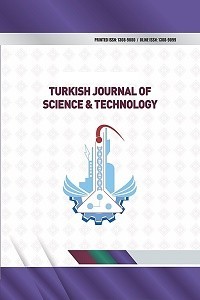Investigation of Diffusion and Adsorption of Acetone in Building Materials by Dynamic Method
Investigation of Diffusion and Adsorption of Acetone in Building Materials by Dynamic Method
Adsorption, Effective Diffusivity, Acetone Gypsum Plaster, Dynamic Method,
___
- 1. Wang, X., Zhang, Y. and Xiong, J. (2008). Correlation between the solid/air partition coefficient and liquid molar volume for VOCs in building materials. Atmospheric Environment, 42, 7768-7774. 2. T. Uragami, H. Yamada, and T. Miyata. (2001). Removal of dilute volatile organic compounds in water through graft copolymer membranes consisting of poly (alkylmethacrylate) and poly(dimethylsiloxane) by pervaporation and their membrane morphology. Journal of Membrane Science, 187, 255-269. 3. Cox, S.S., Zhao, D. and Little, J.C. (2001). Measuring partition and diffusion coefficients for volatile organic compounds in vinylflooring. Atmospheric Environment, 35, 3823-3830. 4. Huang, H. and Haghighat, F. (2002). Modelling of volatile organic compounds emission from dry building materials. Building and Environment, 37, 1349-1360. 5. Liu, Z., Ye, W. and Little, J.C. (2013). Predicting emissions of volatile and semivolatile organic compounds from building materials: A review. Building and Environment, 64, 7-25. 6. Kalender, M. (2016). Determination of effective diffusivities and convective coefficients of CO2 in gypsum plasters by dynamic single pellet experiments. Building and Environment, 105, 164-171. 7. Dogan, M. and Dogu, G. (2003). Dynamics of flow and diffusion of adsorbing gases in Al2O3 and Pd-Al2O3 pellets. AIChE Journal, 49, 3188-3198. 8. Sun, W., Costa, C.A. and Rodrigues, A.E. (1995). Determination of effective diffusivities and convective coefficients of pure gases in single pellets. Chemical Engineering Journal, 57, 285-294. 9. Guangsuo, Y., Jiangua, Y. and Zunhong, Y. (2000). The measurement of effective diffusivity for sulfur-tolerant methanation catalyst. Chemical Engineering Journal, 78, 141-146. 10. Akosman, C. and Zirekgür, N. (2004). Effective diffusivities and convective coefficients for CaO-CaSO4 and CaO-CaCl2 pellets. Chemical Engineering & Technology, 27, 50-55. 11. Dogu, G. and Smith, J. (1975). A dynamic method for catalyst diffusivities. AIChE Journal, 21, 58-61. 12. Dogu, G. and Smith, J. (1976). Rate parameters from dynamic experiments with single catalyst pellets. Chemical Engineering Science, 31, 123-135. 13. Doğu, G., Pekediz, A. and Doğu, T. (1989). Dynamic analysis of viscous flow and diffusion in porous solids. AIChE Journal, 35, 1370-1375. 14. Dogu, T., Yasyerli, N., Dogu, G., McCoy, B.J. and Smith, J.M. (1996). One-sided single-pellet technique for adsorption and intraparticle diffusion. AIChE Journal, 42, 516-523. 15. Yasyerli, N., Dogu, G., Dogu, T. and McCoy, B.J. (1999). Pulse-response study for the humidity effect on sorption of ethyl bromide on clays. AIChE Journal, 45, 291-298. 16. Akosman, C. and Kalender, M. (2009). Analysis of diffusion and adsorption of volatile organic compounds in zeolites by a single pellet moment technique. Clean –Soil, Air, Water, 37, 115-121. 17. Doğu, T., Cabbar, C. and Doğu, G. (1993). Single pellet technique for irreversible and reversible adsorption in soil. Environmental and Energy Engineering, 39, 1895-1899. 18. Bodalal, A., Zhang, J.S. and Plett, E.G. (2000). A method for measuring internal diffusion and equilibrium partition coefficients of volatile organic compounds for building materials. Building and Environment, 35, 101-110. 19. Haghighat, F. and Popa, J. (2003). The impact of VOC mixture, film hhickness and substrate on adsorption/desorptioc Characteris of some building materials. Building and Environment, 38, 959-964. 20. Luo, R. and Niu, J.L. (2006). Determining diffusion and partition coefficients of VOCs in cement using one FLEC. Building and Environment, 41, 1148-1160. 21. Yang, X., Deng, Q. and Zhang, J. (2009). Study on a new correlation between diffusion coefficient and temperature in porous building materials. Atmospheric Environment, 43, 2080-208
- ISSN: 1308-9080
- Başlangıç: 2009
- Yayıncı: Fırat Üniversitesi
Perforeli Kanatlarda Şekil, Boyut Ve Eğim Açısının Isıl Performansa Etkisi
Hisham H. JASİM, Mehmet Sait SÖYLEMEZ
Investigation of Diffusion and Adsorption of Acetone in Building Materials by Dynamic Method
Data Mining Techniques Based Students Achievements Analysis
Dönüş ŞENGÜR, Songül KARABATAK
Rzgar Farooq RASHID, Metin ÇALTA, Asiye BAŞUSTA
Ebru Kavak AKPINAR, İbrahim Halil DEMİR
Keban Baraj Gölünde Yaşayan Aynalı Sazan (Cyprinus carpio L., 1758)’de Bazı Büyüme Parametreleri
Metin ÇALTA, Mustafa DÜŞÜKCAN, Burcu SAYIN
Occupational Health Risk Analysis and Assessment in Cement Production Processes
